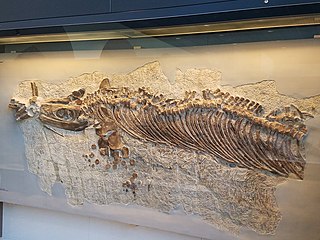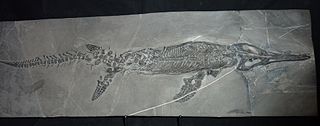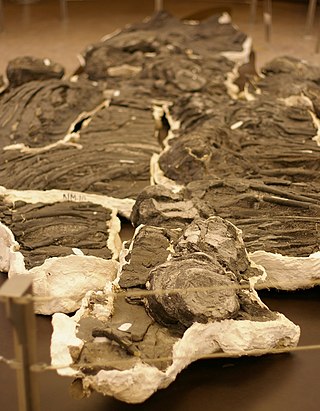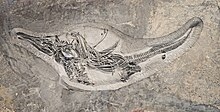
Cymbospondylus is an extinct genus of large ichthyosaurs, of which he is among the oldest representatives, that lived during the Anisian stage of the Middle Triassic in what are now North America and Europe. The first known fossils of this taxon are a set of more or less complete vertebrae which were discovered in the 19th century in various mountain ranges of Nevada, in the United States, before being named and described by Joseph Leidy in 1868. It is in the beginning of the 20th century that more complete fossils were discovered through several expeditions launched by the University of California, and described in more detail by John Campbell Merriam in 1908, thus visualizing the overall anatomy of the animal. While many species have been assigned to the genus, only five are recognized as valid, the others being considered synonymous, doubtful or belonging to other genera. Cymbospondylus was formerly classified as a representative of the Shastasauridae, but more recent studies consider it to be more basal, view as the type genus of the Cymbospondylidae.

Mixosaurus is an extinct genus of Middle Triassic ichthyosaur. Its fossils have been found near the Italy–Switzerland border and in South China.

Shastasauridae is an extinct family of Triassic ichthyosaurs that includes the genera Shastasaurus, Shonisaurus and Himalayasaurus. Many other Triassic ichthyosaurs have been assigned to Shastasauridae in the past, but recent phylogenetic analyses suggest that these species form an evolutionary grade of early ichthyosaurs rather than a true clade or evolutionary grouping that can be called Shastasauridae.

Contectopalatus was a primitive ichthyosaur, an extinct fish-like marine reptile from the Middle Triassic of Germany and China. It was originally named Ichthyosaurus atavus by Quenstedt in 1852, and later reassigned to Mixosaurus. It was recognised as a separate genus by Maisch and Matzke in 1998, though other researchers have classified it as a species of Phalarodon instead.
Californosaurus is an extinct genus of ichthyosaur, an extinct marine reptile, from the Lower Hosselkus Limestone of California, and also the Muschelkalk of Germany.

Shastasaurus is an extinct genus of ichthyosaur from the middle and late Triassic. Specimens have been found in the United States, Canada, and China.

Leptonectes is a genus of ichthyosaur that lived in the Late Triassic to Early Jurassic. Fossils have been found in Belgium, Germany, Switzerland, Spain and the United Kingdom. The type species, L. tenuirostris, reached 4 metres (13 ft) long, while L. moorei reached 3 metres (9.8 ft) long; the largest species, L. solei, was approximately 5–6 metres (16–20 ft) long.

Besanosaurus is a genus of Middle Triassic ichthyosaur from Monte San Giorgio of Italy and Switzerland, containing the single species B. leptorhynchus. Besanosaurus was named by Cristiano Dal Sasso and Giovanni Pinna in 1996, based on the nearly complete flattened skeleton BES SC 999, the holotype specimen. This skeleton is preserved across multiple thin rock slabs spanning 3.5 by 4 metres when assembled and took thousands of hours to prepare. Additional specimens from Monte San Giorgio that have previously been considered separate genera, including a partial skull named Mikadocephalus and a well-preserved, largely complete skeleton, have been reinterpreted as additional specimens of Besanosaurus.
Callawayia is an extinct genus of ichthyosaur. It contains the species Callawayia neoscapularis.

Hudsonelpidia is an extinct genus of small parvipelvian ichthyosaur known from British Columbia of Canada.

Phalarodon is an extinct genus of mixosaurid ichthyosaur known from the Middle Triassic. Its name is derived from the Greek φάλαρα (phálara) and odon ("tooth"). The genus has had a tumultuous history since its classification in 1910, with different workers describing species under different genera or declaring the genus to be a nomen dubium. Currently three species are recognized, but more have been identified in the past.
Wimanius is a genus of ichthyosaur from the Middle Triassic of Switzerland, containing a single species, Wimanius odontopalatus. It was described by Michael Maisch and Andreas Matzke in 1998 based on an incomplete skull from Monte San Giorgio, a mountain on the Swiss-Italian border. Wimanius possesses teeth on its palate, though whether they were located on the palatine or pterygoid is disputed. Other features of Wimanius include a large orbit and jugals with two rami of similar lengths. Different phylogenetic placements of Wimanius have been recovered by different studies, including it being a mixosaurid relative or a merriamosaur, and a monotypic family, Wimaniidae has been named for it. However, its validity has also been questioned, and synonymy with various other genera has been proposed.
Mixosauridae was an early group of ichthyosaurs, living between 247.2 and 235 million years ago, during the Triassic period. Fossils of mixosaurs have been found all over the world: China, Timor, Indonesia, Italy, Germany, Spitsbergen, Switzerland, Svalbard, Canada, Alaska, and Nevada.
Guanlingsaurus is an extinct genus of shastasaurid ichthyosaur from the Late Triassic of China. It grew up to 8.3 metres (27 ft) in length and has a wide, triangular skull with a short and toothless snout.
Xinminosaurus is an extinct genus of cymbospondylid ichthyosaur known from the Middle Triassic of Guizhou Province, China.
Quasianosteosaurus is an extinct genus of basal ichthyosaur known from the late Early Triassic of Spitsbergen of the Svalbard archipelago, Norway. It was first named by Michael W. Maisch and Andreas T. Matzke in 2003 and the type species is Quasianosteosaurus vikinghoegdai. The generic name is derived from Latin quasi, "almost", and Greek anosteos, "boneless" and sauros, "lizard", regarding the preservation of the holotype which is almost exclusively a natural cast of the skull with very little original bone. The specific name is derived from Vikinghøgda, "Mount Viking", where the holotype was found. Quasianosteosaurus is known only from the holotype MNHN Nr. SVT 331, a partial three-dimensionally preserved skull consisting of the snout and orbital and postorbital regions. The skull is by far the largest Early Triassic ichthyosaur skull known, with an estimated cranial length of 50 cm (20 in). It was collected from the lowermost Grippia Niveau of the Sticky Keep Formation, Sassendalen Group at Mount Viking, Sassendalen. A phylogenetic analysis performed by Maisch & Matzke (2003) found it to be a basal ichthyosaur, sister taxon to Hueneosauria.

Pachygonosaurus is a genus of ichthyosaur from Upper Silesia, Poland. It was described in 1916 by Friedrich von Huene and it has one single species, Pachygonosaurus robustus, based solely on the holotype, composed of two vertebral centra discovered in 1910, with a further three vertebrae also possibly belonging to the genus. Nowadays, Pachygonosaurus is considered a nomen dubium.
Barracudasaurus is a dubious genus of ichthyosaur from the Triassic of China, containing the single species B. maotaiensis.



















